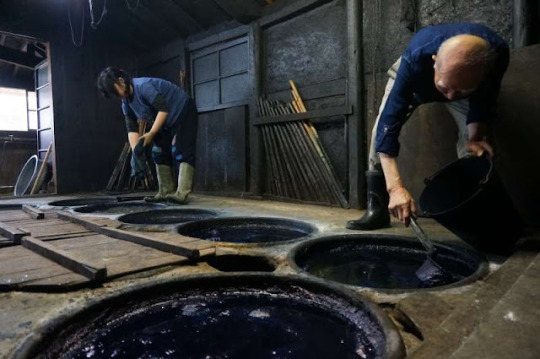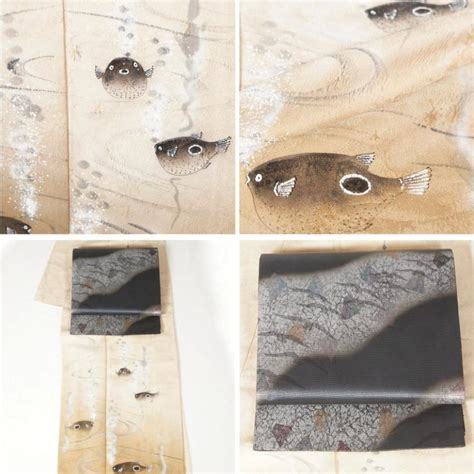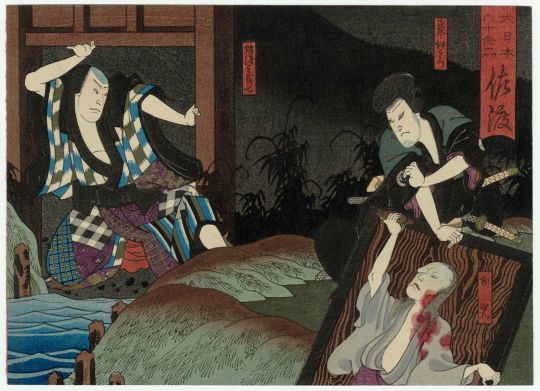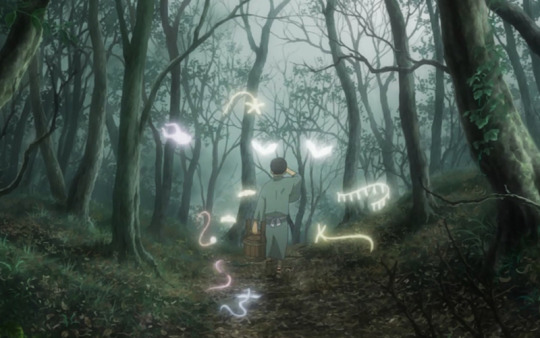#irocore
Explore tagged Tumblr posts
Note
Hello! First off, your blog is such an important resource for me in kimono colours and patterns. I’m making a manga when the details of there kimonos are rather important for the time that passes. And I was wondering what the colours/patterns are for each of the four seasons?
Hi and thank you for your kind words <3 I hope my answer will help you with your manga, don't hesitate to link me the finished story!
As for your question, seasonal color/patterns is a HUGE subject. Sensibilities and tastes changed across periods - and so did patterns, colors and styles ^^;
With a "modern" (late Edo to modern times) setting in mind, you can have a look at this past ask, where I linked patterns ressources => Japan 72 micro seasons, kigo seasonal words, Kimonolady's Tea ceremony calendar, etc.
As for colors, check those past notes => otterintheflightdeck's color serie, color association + those ressources => kimono colors matching grid (via Kimono Nagoya), kasane no irome (on Sengoku Daimyo / on Kariginu), Irocore color list (in jp but each color has brief english description)
#ask#kimono#kimono patterns#kimono colors#72 micro seasons#kigo#seasonal words#kasane no irome#color matching grid#irocore
109 notes
·
View notes
Text

@threeleggedskiddo braincore tinselcore gfuelcore scapegoatcore kylecore mayatimecore ryancore jamiecore (and actually you probably don’t know these next few) Noxccore hostcore serucore seritonincore irocore inversecore uhhhhhh and prob more
#I keep the top bit in all my fanfic screenshots so that I can find them in my gallery later lmaoo#comedic note: only some of these characters are trans#(slash use ‘nontraditional’ pronouns)
3 notes
·
View notes
Text
Broken-Apart Heart (バラバラココロ) by Kairiki Bear
youtube
CW: Allusions to Suicide
Fun fact: when I first heard Kairiki Bear’s songs back in about... 2013, I didn’t like them at all! I dunno what’s changed, but now I really like them, and often find myself humming them (especially this and Lemming-ming).
This was partly driven by how much I like this song in general, and partly, like my SNOBBISM translation, by the errors I found in the most-watched subtitled version on Youtube.
Also, an important part of the song (what the numbers mean) seems to be left out a lot!
I did get a little bit biased towards representing the rhythm of the Japanese here, that’s why in the chorus there’s some repeated words and the English is split up to the syllables of ‘Jin jin jin’.
I also have a fair amount notes for this song down the bottom!
漢字
Romaji
English
スッカラカン 部屋の隅 突っ立って sukkarakan heya no sumi tsuttatte A down-and-out just standing in the corner of the room,
有害な夢描いて 1234 yuugai na yume egaite wan tsuu san shi Imagining a harmful dream, 1 2 3 4 (wanting to die) (1)
将来性 ひとかけら 頂戴な shouraisei hitokakera choudai na Give me just a piece of my future potential, please?
円満DAY そんな未来 望んでました enman DAY sonna mirai nozondemashita A day where everything goes well, that’s the kind of future I was wishing for.
スッカラカン HP(ライフ)もドンドン減ってって sukkarakan Life mo dondon hettette Out of money, my life's also falling out from under me,
くだらない生き様を 1 2 3 4 kudaranai ikisama wo wan tsuu san shi This useless way of life, I just 1 2 3 4 (want to die)
求愛性 まくり腕 引っ掻いて kyuuai-sei makuriude hikkaite A personality of wooing others, clawing at my bared arms,
存在感 恋焦がれ 2234 sonzai-kan koikogare ni ni san shi Longing for a sense of being, 2 2 3 4 (suddenly dying) (2)
ココロこの頃 コロシテ真っ平ら 笑顔の【笑】の字も忘れ去って冷帯 kokoro kono koro koroshite mattaira egao no 'e' no ji mo wasuretesatte reitai Not too long ago, my heart, killed, became a completely flat, subartic region that has forgotten the word for the ‘smiling’ of a ‘smiling face’. (3)
感情 殲滅 エッサホイサ kanjou senmetsu essahoisa All emotions wiped out, hip hip hooray! (4)
ほら這いつくばって『シアワセ』求めて hora haitsukubatte 'shiawase' motomete Look, I'm searching for 'happiness' whilst on all fours!
心情 鮮烈エッサホイサ shinjou senretsu essahoisa Vivid emotions, hip hip hooray!
ほら バラバラ 見失った整合性 hora barabara miushinatte seigousei See, their integrity that's been shattered and lost!
大大大大 大キライです dai dai dai dai daikirai desu I I I I I hate it so very much.
綺麗事だらけの人人人 kireigoto darake no jin jin jin Those people masking over ev’-ry-thing
ララララ さよなラです ra ra ra ra sayonara desu Bye bye bye bye For now, it's goodbye!
スッカラカン 『 』だけの人生 sukkarakan kuuhaku dake no jinsei To this life, a completely empty blank space!
アッケラカン 部屋の中心 Akkerakan heya no chuushin Looking disconnected from everything, just hanging in the centre
吊ったって tsuttatte of the room,
生命線 大事できっと 1234 seimeisen daiji de kitto 1 2 3 4 My lifeline, seriously, definitely 1 2 3 4 (want to die)
消耗性 がっつり充電 shoumou-sei gattsuri juuden Always exhausted, properly recharging
減ってって hettette less and less
デイバイデイ ゆったりじっと 任意惨死(2234?) Day By Day yuttari jitto nin'i zanshi Day By Day, taking it easy, motionlessly, suddenly dying...?
ドロドロココロ どの事を吐露 轟く怒濤 トロケル妥当 ヘドロの路頭 怒号で渡航 dorodoro kokoro dono koto wo toro todoroku dodou torokeru datou hedoro no rotou dogou de tokou A sordid heart, being opinionated about some thing, roaring waves, melting validity, sludge at the wayside, an angry shout mid-travel,
嗚呼 もう 病めにしましょう aa mou yame ni shimashou Ah, no more, let's make myself sick!
感情 殲滅 エッサホイサ kanjou senmetsu essahoisa All emotions wiped out, hip hip hooray!
ほら地べた這って『コウフク』求めて hora chibeta hatte 'koufuku' motomete Look, I crawl on the bare earth searching for my 'joy'!
惨状 連結 エッサホイサ sanjou renketsu essahoisa A series of unfortunate events, hip hip hooray! (5)
ほら 真っ赤に腫れた心臓 ぎゅっとして hora makka ni hareta shinzou gyutto shite See how my heart, swollen up and red, is fit to burst!
大大大大 大キライです dai dai dai dai daikirai desu I I I I I hate them so very much.
御行儀良く振る舞う人人人 ogyougi yoku furumau jin jin jin Those people whose manners are a-maz-ing.
ララララ 前かラです ra ra ra ra mae kara desu For for for for for a while, I
停滞感 息も出来ない teitai-kan iki mo dekinai have felt so stagnant, I can't even breathe.
「こっちの水は甘いな」って 勝手だねって模範生 kocchi no mizu wa amai na tte katte da ne tte mohansei "Isn't saying ‘Ain't this water sweet?’ selfish?" said the model student.
「どっちの水も苦いな」って 言ってたねって劣等生 docchi no mizu mo nigai na tte itteta ne tte rettousei "Didn't they say 'Ain't all water bitter?'" said the bad student.
群青清潔 無いさ無いさ 相も変わらず トモダチごっこです gunjou seiketsu nai sa nai sa ai mo kawarazu tomodachi-gokko desu There's no, no pure ultramarine, as always, it's ‘pretend friend time’. (6)
戦場献血 痛がりさ トロトロトロに零れた脳回路 senjoukenketsu itagari sa torotorotoro ni koboreta noukairo Giving blood on the battlefield looks painful. My mushy neural circuitry thickly spilled out.
感情 殲滅 エッサホイサ kanjou senmetsu essahoisa All emotions wiped out, hip hip hooray!
ほら這いつくばって『死合わせ』もう止めて hora haitsukubatte 'shiawase' mou tomete See, I'm on all fours, I’ve already suppressed my 'happiness' , (7)
MISSION 全滅 エッサホイサ MISSION zenmetsu essahoisa Mission: annihilation, hip hip hooray!
ほら 真っ赤に晴れた太陽から逃避 hora makka ni hareta taiyou kara touhi See how I flee from the brightly shining red sun.
大大大大 大好きなんです dai dai dai dai daisuki na ndesu I I I I I love it so much,
アイソワライの裏で傷ジンジン aisowarai no ura de kizu jinjin The wounds behind a forced smile just throb-bing.
ララララ 来世は結構です ra ra ra ra raise wa kekkou desu I've I’ve I’ve I’ve I’ve had my fill, no afterlife, please,
スッカラカン 『 』だけの人生 sukkarakan kuuhaku dake no jinsei for this life, a completely empty blank space!
スッカラカン バラバラココロ sukkarakan barabara kokoro A completely spent, shattered heart it is!
NOTES
(1) This is an important part of the song! I knew that Kairiki Bear wouldn’t just have random numbers in the song with no meaning, seeing how they like wordplay just as much as Maretu, and the later use of kanji and numbers seals the deal. These numbers have definite meaning! But how did I get that meaning?
The use of both English and Japanese readings creates a natural barrier between the first two numbers and the last two, so I could guess it was ‘Want to’ for ‘1 2′. Judging how later on, ‘3 4′ is given as 惨死, zanshi, ‘a tragic death’, I’m guessing that’s what it’s supposed to be throughout the song. Since the Japanese would be zanshi shitai, ‘I want to tragically die’, ‘want to die’ makes sense, or at least it does to me!
For the first instance of 2 2 3 4, I merely used the given kanji compound from later in the song.
(2) Sonzaikan is a word by itself in Japanese, referring to someone’s ‘presence’ (e.g. ‘his presence filled the room’), but I think it’s use here is actually a suffixed compound, sonzai-kan. This gives it the meaning of ‘a sense of existing’, which, given that most of the song is about feeling empty, fits better.
(3) This line is a mess in Japanese, there could be a lot of different interpretations here, but I think mine works even though I had to fudge it a bit.
(4) Essahoisa is a difficult phrase. It’s used in the carrying of mikoshi, Japanese portable shrines, at festivals, but doesn’t have only one use. It’s equivalent to both ‘heave ho’ and ‘hooray’, and the latter seemed to work better, so that’s what I went with
(5) Yes this is a totally valid way of translating this phrase whilst preserving the meaning. Renketsu means ‘connecting’ in mechanical/electrical sense, as does ‘series’, plus the general idea of a succession of bad things happening together is kept! Also, it’s a nice little reference for people to spot~
(6) I’m not entirely sure if there’s significance to the colour ultramarine in Japanese, and this isn’t the first time I’ve seen it used in a Vocaloid song (Jin’s Gunjou Rain comes to mind). The closest I could get is that it used to be a very valuable paint due to being made of lapis lazuli? I checked irocore, but it doesn’t give any more detail than that.
(7) This is a pun which conflates the word shiawase for ‘happiness’, used similarly earlier in the song, with the rare, sort of made-up(?) word 死合わせ, shi-awase, which means, according to searching on google, ‘happiness from being with someone till you die’.
14 notes
·
View notes
Text
日本大熱「誕辰和色」測驗,找出你生日專屬顏色及性格分析!

對於不同人來說,每種顏色都能帶出不同感覺和意義,那麼你有想過自己出生的日期也能以一種顏色作代表嗎?對於日本人而言,顏色就像其它的藝術作品一樣,深深在他們的生活和文化中展示出來,如畫作、紡織品、陶瓷、詩歌和文學等,而他們更有著從歷史中流傳下來所謂的日本傳統顏色(和色),每一種顏色都有著它的歷史、起源、傳統名稱和代碼等。專門介紹日本傳統顏色的 Irocore 網站就創作了一個名為「誕辰和色」的系統,顧名意思就是生日的顏色,除了讓你找到你生日專屬的和色是甚麼外,也有對你的性格分析和讓你得到啟發的東西。

由 Irocore 提供的「誕辰和色」是跟日本占卜師白龍恵子合作,由 Irocore 提供一年每天不同的和色,而白龍恵子則提供性格分析和啟發物等。只要到 Irocore「誕辰和色」的網站,輸入你的出生日期,就會找到屬於該天的和色和性格分析等資訊,除了日文,網站還貼心的提供英文和中文解釋。你也可以點選得到更多該和色的詳盡解釋,得知該和色的資訊、歷史等資料。快看看屬於你的顏色是甚麼吧!
>>按此進入 Irocore「誕辰和色」網站
延伸閱讀: >>最特別的紀念方法:到 NASA 這個網站找出你生日那天的星象照!
>>只有 0.2% 的人得滿分!10 條問題測���你對色彩的感敏度有多高!
Follow us on Facebook: fb.com/POPBEE Follow us on Instagram: Instagram.com/POPBEE
0 notes
Text
irocore replied to your post:I’m Brazilian but I really want to see Germany win...
Why That?
2 reasons:
1st- im going to travel next sunday (the final day) and the game will be in rio (where i live), and it's going to be traumatic to go to the airport even if brazil doesn't play the final, playing will be so much worse (call me selfish i dont care lol)
2nd- im not approving the world cup here, i've never approved it. and i do believe that the final is pre planned
0 notes
Note
Hello! I love your blog bc it helps me a lot with writing and crafting. Thank you so much for making it!
Are there any patterns that deal with poison? Either in the pattern or in the dyeing process?
Even if there's not I'm glad you and this blog exist 💗
(anon continues) Poison in the dyeing process, like when green dresses were dyed with copper arsenite and it was extremely deadly.
Or a pattern of someone being poisoned, like a historical/folktale.
_______________________________________
Thank you for your kind words <3 I tried to keep things organized but the subject is huge so my of the top of my head answer is going in many directions. I hope you'll still find what you need :3
I'll briefly cover here dyes and (pigments), poison motifs, real life and supernatural poisonings. Buckle up we've got a long post ahead!
____ ABOUT DYE
Tbh I had to think for a moment because I don't recall major "poison" stories linked to dyes in Japan, be it fictionous or real (yet that doesn't mean none ever happened, especially considering Japan's history of industrial poisonings...).
Most gruesome details in the fabric industries I know of are about the horrific life & work conditions of female laborers in spinning mill manufactures (as in many countries, Japan industrialization process was ghastly...).
If potters and dyers had excellent practical knowledge, chemistry as a science officially started kind of late in Japan as it was not a local interest, and as rangaku (study of Western knowledge) often favored other subjects like medicine or warfare.
So, until the introduction of aniline dyes (not textile related, but this article about the use of synthetic dyes in ukiyoe printing is super interesting), Japanese worked with "natural" dyes, like ai (indigo) which was the most used during Edo period.
As with any ingredient, being natural doesn't equal safety. Some mixtures could be quite potent/foul, and process could be dangerous. Plants and minerals base ingredients could be toxic (cinnabar and orpiments were then used as paint pigments, and lead could be found in make up), as were mordants used to set colors.
If you want to easily overview which ingredients were used to create colors, I recommand browsing [Irocore] which presents colors with explanation in English in their database (pick a color then scroll down).
Not related to poison, but ai (indigo) is traditionally prepared in aigame/enormous floor set jars I find utterly terrifying:

I don't know if this tidbit can help you, but some dyes and mordants actually damage the fabric overtime, leaving them brittle (silk desintegrates after a while which is a huge issue in textile conservation).
____ POISON MOTIFS
Concerning "poison" themed patterns, none would be actually used traditionally on a kimono or an obi beside novelty items ^^;
For example, many plants can be toxic, but I don't see them set as pattern for this property - they'd rather refer to a poem, be a symbol of the passing of seasons etc. Fuji (wisteria) can be quite harmful, yet it's a beloved traditional motif in Japan.
You have much more chances to find pattern with kujaku (peacock) which are thought to be impervious to poison in Buddhism, than say venomous mukade (centipede) or the horrific ômukade (a youkai I covered in a folktale).
Snakes like the habu and mamushi are dangerous, but if used as pattern snakes are most often auspicious and linked to rain dragons or goddess Benzaiten.
If you squint hard, toxic fugu could count as poison pattern, but such a seasonal delicacy as a motif would mostly underline wealth (as those fishes are pretty expensive as they are prepared by specialized chefs), a kind of carpe diem spirit, or just a fun pattern because fugu balloon shape is cute ;)

____ POISON MURDERS
Poisoning was certainly a thing is Japan since ancient times (see kodoku sorcery). Poisons were for example used in some fishing techniques.
I am pretty sure some kuge and buke were disposed of this way - even thought poison was seen as a coward weapon (hence why its supposed to be only used by shinobi/ninja - even if this "fact" is opened to a lot of discussions!).
During Edo period, such murders made up the news and penny dreadful-like illustrated books favored by city dwellers in need of a fright. But those stories didn't pass to posterity beside cheap ukiyoe plates, and were never as popular as some shinjû (double suicides) or ghost revenges like poor poisoned and murdered Oiwa's:

____ SUPERNATURAL POISONINGS
If your poison is both physical and metaphorical illbeing, mushi could be your guys ^^ This term actually covers everything small and crawling, from real worms and insects, to anything inside one's body causing distress - be it a parasite, an unknown illness, an overboard emotion, a curse etc. If you've read/seen Mushishi you've got what I mean:

In fact any illness-causing being could count as poison-bringer. Hôsôkami (smallpox demon) was truly feared by all before vaccination was introduced in Japan.
Finally, continuing the supernatural poisoning trail, best girl is probably legendary fox witch Tamamo no Mae who among other terrible deeds made emperor Konoe fall sick with poisonous miasma (some version of the story attributes the disease to another monster, the nue). I covered a similar murderous kitsune folktale here.
#ask#japan#japanese history#dye#pattern#motif#poison#venomous#illness#natural dye#aniline dye#mordant#pigment#kujaku#peacock#mukade#centipede#omukade#youkai#snake#hebi#mamushi#habu#benzaiten#fugu#mushi#insect#mushishi#Hôsôkami#smallpox demon
117 notes
·
View notes